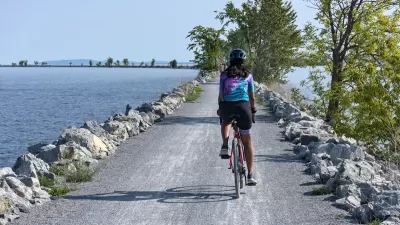There's still a long way to go to get to the finish line on the conversion of a rail corridor into a bike trail that could connect important parts of the city, but Cincinnati is currently pulling lots of purse strings to make it happen.
Chris Wetterich reports on the goings on with the proposed Wasson Way bike trail in Cincinnati, where local officials recently sent a request for funding from the state to help make the plan a reality.
Mayor John Cranley and City Manager Harry Black sent the letter, which sums up the ambition of the project:
"The trail utilizes an existing, unused rail corridor and, when completed, will connect eight Cincinnati neighborhoods and the communities of Norwood, Mariemont and Fairfax and 83,000 people living within 1 mile of the trail….It will provide alternative access to five major development sites, including sites at Xavier University and near Uptown, and will help make our community more attractive to families and to the talented skilled workforce that will propel the economy of the region."
So far the project has brought in a $500,000 grant from the Ohio Department of Natural Resources and a $12 million purchase agreement with Norfolk Southern Railroad Co. "to buy 4.1 miles of track needed for the project," according to Wetterich. The article includes more details about the funding requirements for the project, along with some maps and conceptual renderings of the potential addition to the city.
FULL STORY: Cincinnati identifies a new source to fund Wasson Way

Maui's Vacation Rental Debate Turns Ugly
Verbal attacks, misinformation campaigns and fistfights plague a high-stakes debate to convert thousands of vacation rentals into long-term housing.

Planetizen Federal Action Tracker
A weekly monitor of how Trump’s orders and actions are impacting planners and planning in America.

San Francisco Suspends Traffic Calming Amidst Record Deaths
Citing “a challenging fiscal landscape,” the city will cease the program on the heels of 42 traffic deaths, including 24 pedestrians.

Defunct Pittsburgh Power Plant to Become Residential Tower
A decommissioned steam heat plant will be redeveloped into almost 100 affordable housing units.

Trump Prompts Restructuring of Transportation Research Board in “Unprecedented Overreach”
The TRB has eliminated more than half of its committees including those focused on climate, equity, and cities.

Amtrak Rolls Out New Orleans to Alabama “Mardi Gras” Train
The new service will operate morning and evening departures between Mobile and New Orleans.
Urban Design for Planners 1: Software Tools
This six-course series explores essential urban design concepts using open source software and equips planners with the tools they need to participate fully in the urban design process.
Planning for Universal Design
Learn the tools for implementing Universal Design in planning regulations.
Heyer Gruel & Associates PA
JM Goldson LLC
Custer County Colorado
City of Camden Redevelopment Agency
City of Astoria
Transportation Research & Education Center (TREC) at Portland State University
Jefferson Parish Government
Camden Redevelopment Agency
City of Claremont





























